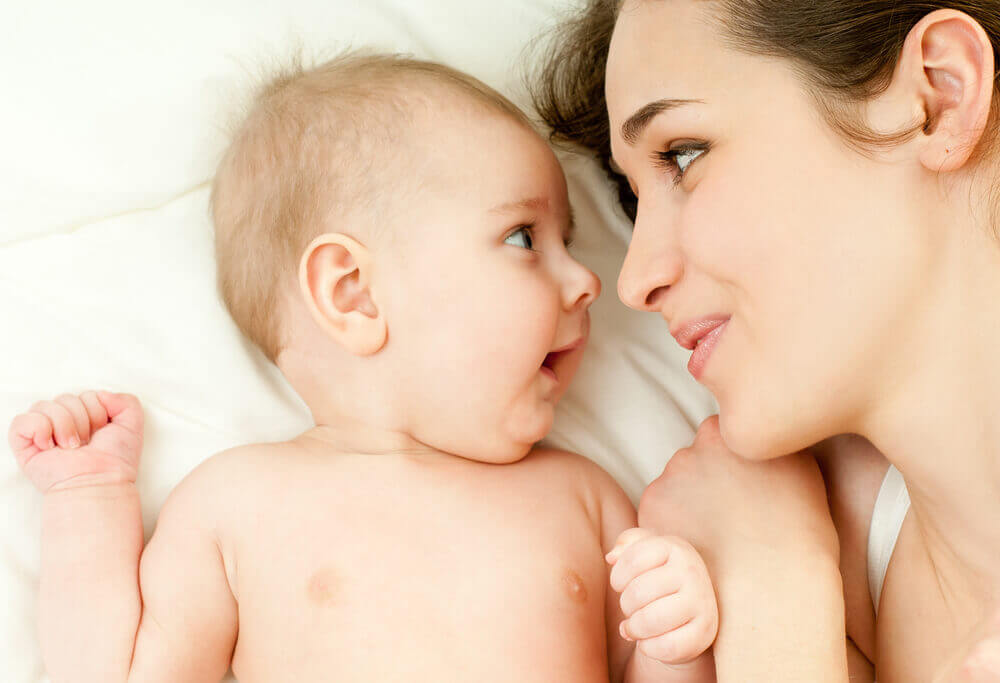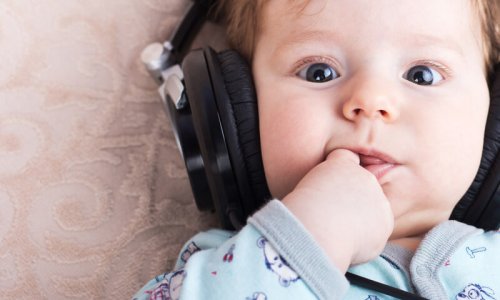How Does Nonverbal Communication Develop in Children?

Nonverbal communication in children is the first way through which they begin to develop a relationship with their parents; it occurs when they haven’t yet uttered their first words or have just begun to do so.
The importance of nonverbal communication in children
Nonverbal communication is the interactive way in which children express their emotions without uttering words; whereas verbal communication is acquired through active interaction, i.e., language development, and auditory interaction with parents.
“The time devoted to parent-child communication is a time that marks a transcendental stage in a child’s development.”
Because infants can’t speak, nonverbal communication is their only way of interacting with adults; they’re even able to distinguish different linguistic tones in their parents.
How does nonverbal communication develop in children?
Children use nonverbal communication as a way to get their parents’ attention by expressing their emotions and basic needs. It’s important to carefully observe sounds and gestures as they reveal the following:
- Mood.
- They can warn of disorders or maladjustments.
- Through them, they attract attention.
- Through them, they maintain interpersonal contact.
This innate ability is developed and refined by one’s own personal experience. Learning and maturity allow the association of certain expressions and words; as well as specific actions and emotions.

Facial expressions
The infant or child begins to communicate through facial expressions. This type of nonverbal communication in children is developed through:
- Eye movements
- Some facial movements
- Lip movements
Each of these important aspects goes through a maturing process that’s organized until they reach a concrete unit. There are numerous facial signs that parents should visualize well to observe what the child wants to communicate.
Observe well
Observing facial expressions well is vital to be able to interpret what the child wants to convey.
An example of this is that if a baby wants to express surprise, they’ll do it by opening their eyes; raising their eyebrows, and leaving their mouth wide open and the upper eyelid raised.
If they express joy, it’s easy to observe that the cheeks are raised; the eyes are squinted and the corners of the lips are displaced. Some examples like these help you notice the type of nonverbal communication in children.
Tips to create good communication
You don’t need to wait until the child grows up or begins to speak to create good communication with them; through nonverbal language, this can also be achieved. Some important tips that can promote it are the following:
Look your baby in the face
Facial expressions are a basic and vital way to develop a good communication between parents and their child; this will strengthen the relationship between them, creating a kind of bond that will be strengthened progressively.
Any communication of the child with the parent can be done properly even if they can’t speak. You only need to face the child face-to-face to take advantage of the opportunity.
“Interactive” smile
When dealing with nonverbal communication in children, it’s important to emphasize that smiling is a key factor. Trying to stimulate smiling in the child and smiling constantly as a reaction to their gestures. This is one of the main elements conducive to perfect communication.
Interact with their expressions
A baby’s expressions are variable but no less intense. Pedagogue Cristina Garcia explains that “when a child goes from laughing to crying or from crying to laughing, it’s because they’ve expressed what they were feeling in two different moments, although very close in time.”
Parents then have a precious opportunity to interact with gestures of joy, astonishment, sadness, enthusiasm, expressively bringing their face close to the baby’s face. Replication leads to imitation and from imitation to communicative intent.
Paying attention to gestures and words
All of the above entails paying attention to the gestures and words that parents use. The baby is a sponge and the enormous plasticity of the brain disposes them to receive and process an infinity of stimuli. Among them, the complex universe of human communication.
In an interesting work, researcher Isabel Santis states: “When interacting face to face with a baby, neurotrophins are produced, which favors the creation of synapses, synaptic plasticity, and development of the cortex; endorphins are also produced, which stimulate playful behavior in both”.
Role-playing and theater, nonverbal communication tools
Theater without words or pantomime is very old and has countless universal resources based on gestures, signs, mimics, noises, and silences. Imitating is also a human instinct and babies begin to do it from the first month of life, so role-playing along with music and characterization fills the environment with meaning.
Use music and singing
Many parents have proven that music and singing are determining factors to promote nonverbal communication with the child. These two help brain maturation perfectly, which lays the neurological foundations for future verbal communication.
When the baby begins to make “gurgles” or certain vocalizations, parents should react and try to interact with the baby in the same way, trying to repeat the sounds the baby makes.
This way, communication will become more and more established until, as the months go by, it reaches verbal communication. Creating a much more affectionate and deeper relationship.

Voice modulation
As the baby grows, parents shouldn’t stop using the interactive smile or stop looking at the baby’s face; in fact, it’s appropriate to continue doing so and, if possible, to talk close to the baby’s ear.
In addition, using different tones of voice and rhythm from different places (far away, close, from the side, from the front) will help them develop their sensory abilities.
Use rattles
Rattles are one of the most important allies for parents, as they develop the maturation of the auditory areas of the brain. In order to enhance this exercise, parents can place them at different distances (12 or 15 inches).
Also, using a rattle accompanied by certain facial expressions is a very good way to stimulate your baby.
Parents should never forget that non-verbal communication in children should be stimulated using multisensory systems that allow the integration of all the senses, a method of global brain stimulation that promotes verbal maturation.
And above all, remember that the little ones
“…know much more about emotions than we do because they mainly feel and we, once we reach the adult world, mainly think.”
Cristina García
Nonverbal communication in children is the first way through which they begin to develop a relationship with their parents; it occurs when they haven’t yet uttered their first words or have just begun to do so.
The importance of nonverbal communication in children
Nonverbal communication is the interactive way in which children express their emotions without uttering words; whereas verbal communication is acquired through active interaction, i.e., language development, and auditory interaction with parents.
“The time devoted to parent-child communication is a time that marks a transcendental stage in a child’s development.”
Because infants can’t speak, nonverbal communication is their only way of interacting with adults; they’re even able to distinguish different linguistic tones in their parents.
How does nonverbal communication develop in children?
Children use nonverbal communication as a way to get their parents’ attention by expressing their emotions and basic needs. It’s important to carefully observe sounds and gestures as they reveal the following:
- Mood.
- They can warn of disorders or maladjustments.
- Through them, they attract attention.
- Through them, they maintain interpersonal contact.
This innate ability is developed and refined by one’s own personal experience. Learning and maturity allow the association of certain expressions and words; as well as specific actions and emotions.

Facial expressions
The infant or child begins to communicate through facial expressions. This type of nonverbal communication in children is developed through:
- Eye movements
- Some facial movements
- Lip movements
Each of these important aspects goes through a maturing process that’s organized until they reach a concrete unit. There are numerous facial signs that parents should visualize well to observe what the child wants to communicate.
Observe well
Observing facial expressions well is vital to be able to interpret what the child wants to convey.
An example of this is that if a baby wants to express surprise, they’ll do it by opening their eyes; raising their eyebrows, and leaving their mouth wide open and the upper eyelid raised.
If they express joy, it’s easy to observe that the cheeks are raised; the eyes are squinted and the corners of the lips are displaced. Some examples like these help you notice the type of nonverbal communication in children.
Tips to create good communication
You don’t need to wait until the child grows up or begins to speak to create good communication with them; through nonverbal language, this can also be achieved. Some important tips that can promote it are the following:
Look your baby in the face
Facial expressions are a basic and vital way to develop a good communication between parents and their child; this will strengthen the relationship between them, creating a kind of bond that will be strengthened progressively.
Any communication of the child with the parent can be done properly even if they can’t speak. You only need to face the child face-to-face to take advantage of the opportunity.
“Interactive” smile
When dealing with nonverbal communication in children, it’s important to emphasize that smiling is a key factor. Trying to stimulate smiling in the child and smiling constantly as a reaction to their gestures. This is one of the main elements conducive to perfect communication.
Interact with their expressions
A baby’s expressions are variable but no less intense. Pedagogue Cristina Garcia explains that “when a child goes from laughing to crying or from crying to laughing, it’s because they’ve expressed what they were feeling in two different moments, although very close in time.”
Parents then have a precious opportunity to interact with gestures of joy, astonishment, sadness, enthusiasm, expressively bringing their face close to the baby’s face. Replication leads to imitation and from imitation to communicative intent.
Paying attention to gestures and words
All of the above entails paying attention to the gestures and words that parents use. The baby is a sponge and the enormous plasticity of the brain disposes them to receive and process an infinity of stimuli. Among them, the complex universe of human communication.
In an interesting work, researcher Isabel Santis states: “When interacting face to face with a baby, neurotrophins are produced, which favors the creation of synapses, synaptic plasticity, and development of the cortex; endorphins are also produced, which stimulate playful behavior in both”.
Role-playing and theater, nonverbal communication tools
Theater without words or pantomime is very old and has countless universal resources based on gestures, signs, mimics, noises, and silences. Imitating is also a human instinct and babies begin to do it from the first month of life, so role-playing along with music and characterization fills the environment with meaning.
Use music and singing
Many parents have proven that music and singing are determining factors to promote nonverbal communication with the child. These two help brain maturation perfectly, which lays the neurological foundations for future verbal communication.
When the baby begins to make “gurgles” or certain vocalizations, parents should react and try to interact with the baby in the same way, trying to repeat the sounds the baby makes.
This way, communication will become more and more established until, as the months go by, it reaches verbal communication. Creating a much more affectionate and deeper relationship.

Voice modulation
As the baby grows, parents shouldn’t stop using the interactive smile or stop looking at the baby’s face; in fact, it’s appropriate to continue doing so and, if possible, to talk close to the baby’s ear.
In addition, using different tones of voice and rhythm from different places (far away, close, from the side, from the front) will help them develop their sensory abilities.
Use rattles
Rattles are one of the most important allies for parents, as they develop the maturation of the auditory areas of the brain. In order to enhance this exercise, parents can place them at different distances (12 or 15 inches).
Also, using a rattle accompanied by certain facial expressions is a very good way to stimulate your baby.
Parents should never forget that non-verbal communication in children should be stimulated using multisensory systems that allow the integration of all the senses, a method of global brain stimulation that promotes verbal maturation.
And above all, remember that the little ones
“…know much more about emotions than we do because they mainly feel and we, once we reach the adult world, mainly think.”
Cristina García
All cited sources were thoroughly reviewed by our team to ensure their quality, reliability, currency, and validity. The bibliography of this article was considered reliable and of academic or scientific accuracy.
- Etchepareborda, M. C., Abad-Mas, L., & Pina, J. (2003). Estimulación multisensorial. Revista de Neurología, 36(supl 1), 122. https://www.researchgate.net/profile/Maximo-Etchepareborda/publication/10889560_Multisensory_stimulation/links/5ee40ba1a6fdcc73be77fc98/Multisensory-stimulation.pdf
- García, C. (2013). Las emociones en los niños. Un libro de ayuda y orientación para maestros y padres. EDukame: Revista digital de educación emocional. Recuperado de: https://edukame. com/sites/default/files/pdf_las_emociones_en_los_ninos_v2. 0_previo. pdf. https://edukame.com/sites/default/files/pdf_las_emociones_en_los_ninos_v2.0_previo.pdf
- Moralejo, R. (2008). Bases neurobiológicas en el desarrollo del lenguaje. Logopedia. mail, 9(42), 1-14. https://logopediamail.com/articulos/42b_Moralejo_-_Bases_Neurobiologicas_en_el_desarrollo_del_lenguaje_2008_.pdf
- Oliver, M. Vínculos afectivos y comunicación no verbal en los dos primeros años de vida. Su evaluación en la clínica pediátrica. http://www.enciclopediasaludmental.org.ar/trabajo.php?idt=85&idtt=159
- Silva, I. S. (2018). Una reflexión sobre el concepto de bebé. Revista Educación Las Américas, 6, 29-36. https://revistas.udla.cl/index.php/rea/article/view/23/21
This text is provided for informational purposes only and does not replace consultation with a professional. If in doubt, consult your specialist.








